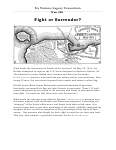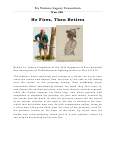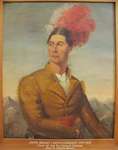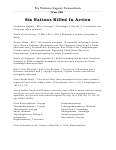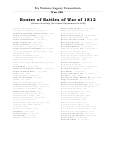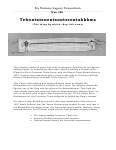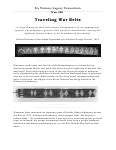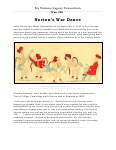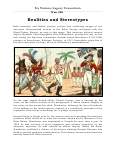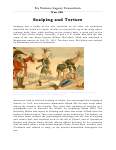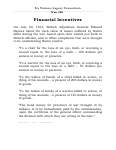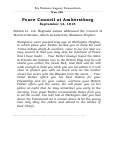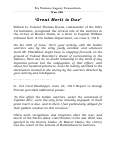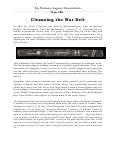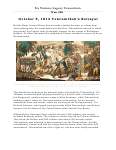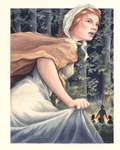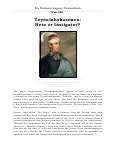Results
- Eighth in a 62 part series, Fight or Surrender describes the remarkable military victory of thirty-six Haudenosaunee (Iroquois Confederacy) warriors, winning in battle against a much larger AmericanEighth in a 62 part series, Fight or Surrender describes the remarkable …
- Bulletin of the Departments of History and Political and Economic Science in Queen’s University. The text describes Captain John Deserontyou and the Mohawk settlement at Deseronto.Bulletin of the Departments of History and Political and Economic Science in …
- Twenty-Sixth in a 62 part series, He Fires, Then Retires is a description by British Lt. James FitzGibbon of the Haudenosaunee (Iroquois Confederacy) warriors fighting tactics in the War of 1812.Twenty-Sixth in a 62 part series, He Fires, Then Retires is a …
- Photo of painted portrait of John Brant, Chief of the Six Nations of the Grand River and Superintendent for the Grand River Mohawk appointed in 1828.Photo of painted portrait of John Brant, Chief of the Six Nations …
- Thirty-Third in a 62 part series, Pledge of the Crown Wampum Belt describes a wampum belt created by the British to represent the ongoing relationship with the Native community after the warThirty-Third in a 62 part series, Pledge of the Crown Wampum Belt …
- Fourteenth in a 62 part series, Six Nations Killed In Action is a list of Native Chiefs and Warriors who were killed in action during the War of 1812. This list was compiled using available informatiFourteenth in a 62 part series, Six Nations Killed In Action is …
- Fifteenth in a 62 part series, Roster of Battles of War of 1812 is a chronological list of the battles that occurred during the War of 1812.Fifteenth in a 62 part series, Roster of Battles of War of …
- Sixteenth in a 62 part series, Tehontatenentsonterontahkhwa describes the Wampum Friendship Belt, and its historical use by Haudenosaunee (Iroquois Confederacy) as a tool of diplomacy.Sixteenth in a 62 part series, Tehontatenentsonterontahkhwa describes the Wampum Friendship Belt, …
- Eighteenth in a 62 part series, Traveling War Belts describes the visual symbolism depicted in the designs of Wampum Belts, and outlines their relationship to Native spiritual ideasEighteenth in a 62 part series, Traveling War Belts describes the visual …
- Nineteenth in a 62 part series, Norton’s War Dance describes John Norton’s participation in a traditional native war dance.Nineteenth in a 62 part series, Norton’s War Dance describes John Norton’s …
- Twentieth in a 62 part series, Realities and Stereotypes describes the negative racial stereotypes of natives which existed in American and British political cartoon of the early 19th centuryTwentieth in a 62 part series, Realities and Stereotypes describes the negative …
- Twenty-First in a 62 part series, Scalping and Torture describes the use of scalp mutilation in the War of 1812. Employed primarily as a tool of intimidation and psychological warfare by all sides inTwenty-First in a 62 part series, Scalping and Torture describes the use …
- Twenty-Second in a 62 part series, Financial Incentives describes the system British officials had instituted to financially reimburse native warriors and the widows of deceased warriors for losses tTwenty-Second in a 62 part series, Financial Incentives describes the system British …
- Twenty-Third in a 62 part series, Peace Council at Amherstburg excerpts the speech given by British Lt. Col. Reginald James in front of the Council of Western Nations on September 14, 1815. The speecTwenty-Third in a 62 part series, Peace Council at Amherstburg excerpts the …
- Twenty-Fourth in a 62 part series, Great Merit is Due Excerpts quotes from letters by British military leaders acknowledging the enormous role Native Warriors had in ensuring a victory over AmericanTwenty-Fourth in a 62 part series, Great Merit is Due Excerpts quotes …
- Fiftieth in a 62 part series, Cleansing the War Belt describes the blue coloured Wampum Belt which was being used in Native ceremonies in 1815 to celebrate peaceFiftieth in a 62 part series, Cleansing the War Belt describes the …
- Fifty-Second in a 62 part series, Tehcumtheh’s Betrayal describes the circumstances leading up to Tecumseh death on the battlefield on October 5, 1813Fifty-Second in a 62 part series, Tehcumtheh’s Betrayal describes the circumstances leading …
- Illustration upon which the 42cent "Laura Secord: Legendary Patriot" stamp was based (see call# SN90001033).Illustration upon which the 42cent "Laura Secord: Legendary Patriot" stamp was based …
- Niagara Falls Public LibraryNiagara Falls Public Library
- Twenty-Ninth in a 62 part series, Teyoninhokarawen - Hero or Instigator is a discourse on John Norton’s role in the War of 1812Twenty-Ninth in a 62 part series, Teyoninhokarawen - Hero or Instigator is …
When selecting an individual record or object, you will move
to the website of the heritage institution that houses the item.
To return to the search or results pages, select "Back", "Results" or "New Search".
 This project was made possible with the support of the Department of Canadian Heritage
This project was made possible with the support of the Department of Canadian Heritage
through the Canadian Culture Online Strategy.
to the website of the heritage institution that houses the item.
To return to the search or results pages, select "Back", "Results" or "New Search".
 This project was made possible with the support of the Department of Canadian Heritage
This project was made possible with the support of the Department of Canadian Heritage through the Canadian Culture Online Strategy.






